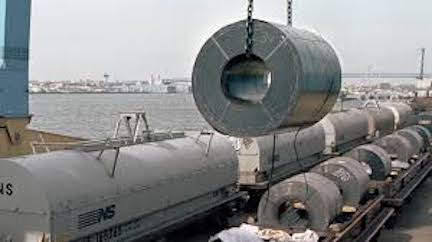So far, trade wars don’t seem to be as “good, and easy to win” as U.S. President Donald Trump promised a year ago when he imposed tariffs on steel and aluminum imports.
The scorecard shows a split decision. U.S. steelmakers Nucor Corp. and United States Steel Corp. saw significant profit gains in 2018. But manufacturers that buy the metal—led by Caterpillar Inc., a top three U.S. exporter—say the tariffs have hurt profits, spurred layoffs and forced some companies to rework supply chains in ways that undercut use of American workers.

Manufacturing showed “a lot of momentum coming out of 2017 into 2018,” said John Mothersole, an IHS Markit analyst in Washington. “But all that momentum evaporated across the course of the year.”
Mothersole sees the tariffs as a tax on U.S. manufacturers, and said he believes they’re likely a drag on the economy as a whole. After all, he said, a lot more people make things from steel than produce it.
Meanwhile, global manufacturing activity has fallen in 10 of 11 months since the U.S. tariffs were imposed, peeling it back to a level last seen in 2016, according to the JPMorgan Global Manufacturing PMI index. That’s occurred as global economic growth is under pressure after a sharp slowdown in 2018, and policy makers await clarity on issues from trade tariffs to Brexit.
To be sure, there are supporters of the tariffs. U.S. Commerce Secretary Wilbur Ross, for instance has downplayed the tariff’s negative effects. Appearing on CNBC at one point, he used a soup can to say most Americans would barely notice the tariffs. The can contained 2.6 cents worth of steel, he said, adding, “if that goes up by 25 percent, that’s six-tenths of one cent.”
On the other side of the equation, Caterpillar, the world’s biggest machinery producer, said it may have lost more than $100 million in 2018 as a result of the tariffs, while beer-maker MillerCoors, the U.S. unit of Molson Coors Brewing Co., has said the aluminum tariffs probably added more than $40 million in costs to its operation.
Mid-Continent Steel and Wire Inc., a maker of nails, has said it’s cutting jobs to offset its added costs from the tariffs, while PanelClaw Inc. and Nuance Energy, suppliers of steel racks for solar panels, say they’re now importing some racks from abroad rather than building them with American workers at home.
On the aluminum side, even U.S. producers are struggling. Chinese exports of aluminum products have risen to record highs, pressuring prices. Century Aluminum Co. reported a fourth-quarter loss, as did Alcoa Corp.’s aluminum division.
“In the big picture, even with 232, things are not so great,” said Mark Hansen, chief executive of trading house Concord Resources Ltd., referring to the tariffs Trump imposed under Section 232 of the Trade Expansion Act of 1962. “The price pressure from the East is still pushing down the market price.”
Hansen believes now is the time to address this. “If we don’t deal with it now as part of this big China trade deal, then 232 is a band-aid that’s just not going to work,” he said.
Here’s a breakdown from other regions:
Europe:
European steelmakers were initially furious about Trump’s tariffs, but not because of fears they might lose access to the U.S. market. Instead, they were concerned that steel heading for the U.S. would be rerouted to Europe.
That fear was somewhat realized, with shipments into Europe—largely from Turkey—increasing about 12 percent last year to the highest level since 2007. That provoked the European Union to implement its own protectionist measures, called safeguarding, that caps the amount of tariff-free imports to the region.
Those measures were implemented last month, with the idea they should be able to curb the recent growth in imports.
The European aluminum industry, meanwhile, faces a different situation, according to Gerd Götz, director general of European Aluminum, a lobby group for the industry. The combined impact of the metal tariffs and the U.S.-China tariffs led to increased European sales of aluminum products to the U.S., since the import tax on China was higher than the all-in toll placed on Europe.
U.S. imports of aluminum and aluminum products from the EU grew by about 17 percent to $1.72 billion in 2018 compared with the previous year, he said. Meanwhile, the European industry has been pushing for a broader deal to address “China’s unfair subsidized aluminum overcapacity,” Götz said.
Asia:
In Asia, steelmakers have yet to feel much of an impact from the U.S. metal tariffs. China, maker of half the world’s steel, has managed to exert greater control over its steel market through structural reforms that mitigated their effect, according to Yoku Ihara, the head of Growth & Value Stock Research of Japan.
China’s push to create domestic demand has “so far worked, keeping steel market conditions favorable,” Ihara said. “That factor has outweighed the effect of the tariffs.”
Ihara, though, warns that those conditions may not last. China’s economy faces a turning point as the negative impact of the trading war with U.S. has begun to emerge outside the steel sector. The Asian giant has been on a building spree, at a faster pace than needed, Ihara said, and could eventually see demand fall short.
“Steelmakers will need to be prepared for a radical change in market conditions,” he said.
Japanese steelmakers have also seen limited impact from the tariffs as many of their products are getting approval through U.S. Commerce Department exemptions.
Shinichi Nakamura, executive vice president of Nippon Steel & Sumitomo Metal Corp., Japan’s biggest producer, was initially concerned that the metal blocked by the U.S. tariffs would flow into Southeast Asia, hitting Japan’s export market, but such a phenomenon hasn’t occurred, he said.










